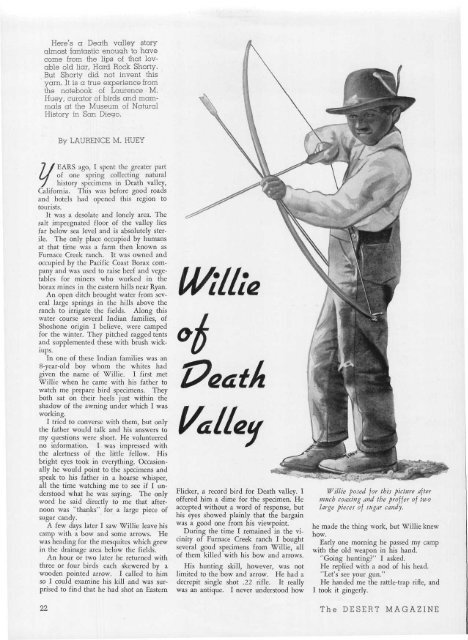G A Z I N E - Desert Magazine of the Southwest
G A Z I N E - Desert Magazine of the Southwest
G A Z I N E - Desert Magazine of the Southwest
You also want an ePaper? Increase the reach of your titles
YUMPU automatically turns print PDFs into web optimized ePapers that Google loves.
Here's a Death valley story<br />
almost fantastic enough to have<br />
come from <strong>the</strong> lips <strong>of</strong> that lovable<br />
old liar, Hard Rock Shorty.<br />
But Shorty did not invent this<br />
yarn. It is a true experience from<br />
<strong>the</strong> notebook <strong>of</strong> Laurence M.<br />
Huey, curator <strong>of</strong> birds and mammals<br />
at <strong>the</strong> Museum <strong>of</strong> Natural<br />
History in San Diego.<br />
By LAURENCE M. HUEY<br />
7 / EARS ago, I spent <strong>the</strong> greater part<br />
(J <strong>of</strong> one spring collecting natural<br />
y history specimens in Death valley,<br />
California. This was before good roads<br />
and hotels had opened this region to<br />
tourists.<br />
It was a desolate and lonely area. The<br />
salt impregnated floor <strong>of</strong> <strong>the</strong> valley lies<br />
far below sea level and is absolutely sterile.<br />
The only place occupied by humans<br />
at that time was a farm <strong>the</strong>n known as<br />
Furnace Creek ranch. It was owned and<br />
occupied by <strong>the</strong> Pacific Coast Borax company<br />
and was used to raise beef and vegetables<br />
for miners who worked in <strong>the</strong><br />
borax mines in <strong>the</strong> eastern hills near Ryan.<br />
An open ditch brought water from several<br />
large springs in <strong>the</strong> hills above <strong>the</strong><br />
ranch to irrigate <strong>the</strong> fields. Along this<br />
water course several Indian families, <strong>of</strong><br />
Shoshone origin I believe, were camped<br />
for <strong>the</strong> winter. They pitched ragged tents<br />
and supplemented <strong>the</strong>se with brush wickiups.<br />
In one <strong>of</strong> <strong>the</strong>se Indian families was an<br />
8-year-old boy whom <strong>the</strong> whites had<br />
given <strong>the</strong> name <strong>of</strong> Willie. I first met<br />
Willie when he came with his fa<strong>the</strong>r to<br />
watch me prepare bird specimens. They<br />
both sat on <strong>the</strong>ir heels just within <strong>the</strong><br />
shadow <strong>of</strong> <strong>the</strong> awning under which I was<br />
working.<br />
I tried to converse with <strong>the</strong>m, but only<br />
<strong>the</strong> fa<strong>the</strong>r would talk and his answers to<br />
my questions were short. He volunteered<br />
no information. I was impressed with<br />
<strong>the</strong> alertness <strong>of</strong> <strong>the</strong> little fellow. His<br />
bright eyes took in everything. Occasionally<br />
he would point to <strong>the</strong> specimens and<br />
speak to his fa<strong>the</strong>r in a hoarse whisper,<br />
all <strong>the</strong> time watching me to see if I understood<br />
what he was saying. The only<br />
word he said directly to me that afternoon<br />
was "thanks" for a large piece <strong>of</strong><br />
sugar candy.<br />
A few days later I saw Willie leave his<br />
camp with a bow and some arrows. He<br />
was heading for <strong>the</strong> mesquites which grew<br />
in <strong>the</strong> drainage area below <strong>the</strong> fields.<br />
An hour or two later he returned with<br />
three or four birds each skewered by a<br />
wooden pointed arrow. I called to him<br />
so I could examine his kill and was surprised<br />
to find that he had shot an Eastern<br />
Flicker, a record bird for Death valley. I<br />
<strong>of</strong>fered him a dime for <strong>the</strong> specimen. He<br />
accepted without a word <strong>of</strong> response, but<br />
his eyes showed plainly that <strong>the</strong> bargain<br />
was a good one from his viewpoint.<br />
During <strong>the</strong> time I remained in <strong>the</strong> vicinity<br />
<strong>of</strong> Furnace Creek ranch I bought<br />
several good specimens from Willie, all<br />
<strong>of</strong> <strong>the</strong>m killed with his bow and arrows.<br />
His hunting skill, however, was not<br />
limited to <strong>the</strong> bow and arrow. He had a<br />
decrepit single shot .22 rifle. It really<br />
was an antique. I never understood how<br />
Willie posed for this picture after<br />
much coaxing and <strong>the</strong> pr<strong>of</strong>fer <strong>of</strong> two<br />
large pieces <strong>of</strong> sugar candy.<br />
he made <strong>the</strong> thing work, but Willie knew<br />
how.<br />
Early one morning he passed my camp<br />
with <strong>the</strong> old weapon in his hand.<br />
"Going hunting?" I asked.<br />
He replied with a nod <strong>of</strong> his head.<br />
"Let's see your gun."<br />
He handed me <strong>the</strong> rattle-trap rifle, and<br />
I took it gingerly.<br />
22 The DESERT MAGAZINE

















